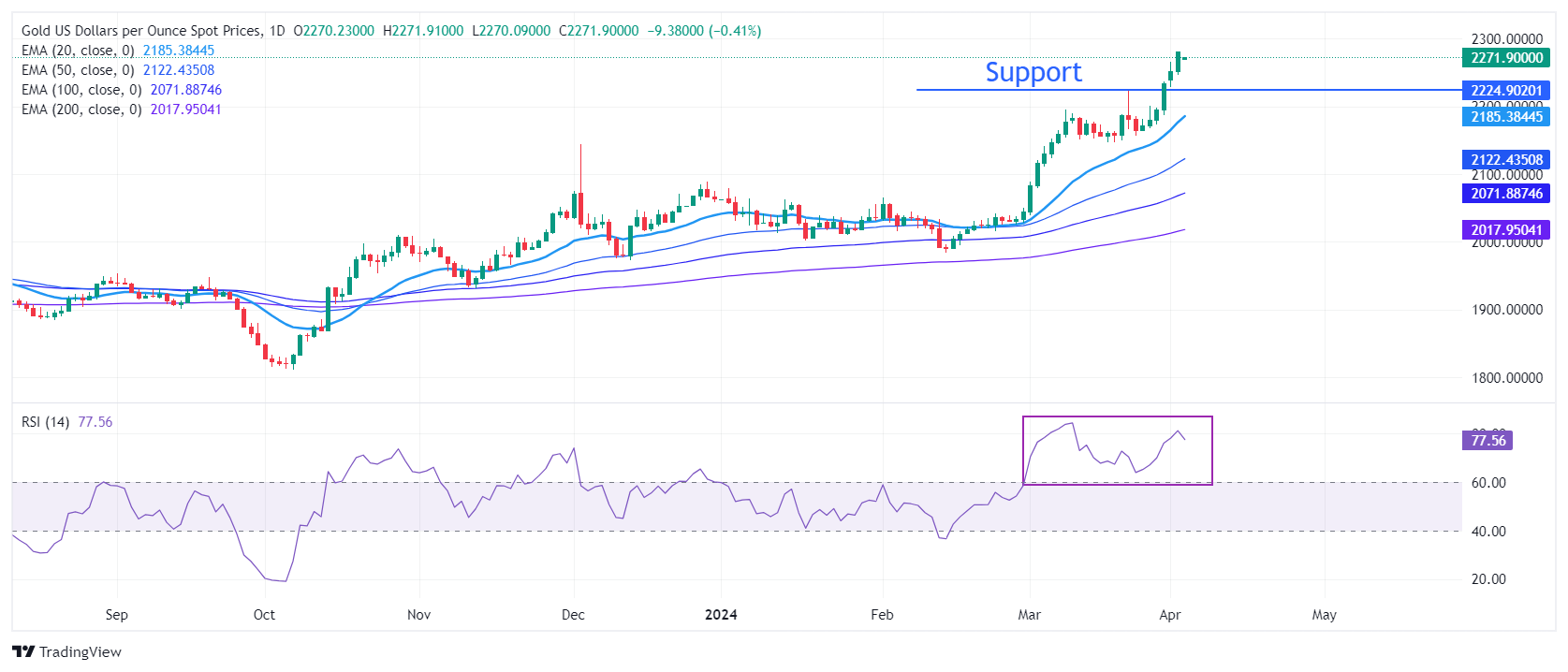- Gold price bounces back to $2,280 after weak US ISM Services PMI
- Fed policymakers see no urgency for rate cuts.
- Investors await the Fed Powell’s speech for fresh guidance on interest rates.
Gold price (XAU/USD) recovers intraday losses and rebounds to fresh all-time highs near $2,280 in Wednesday’s early New York session. The precious metal strengthens after the United States Institute of Supply Management (ISM) reported weak Services PMI data for March. The Services PMI, which represents the service sector that accounts for two-thirds of the US economy, falls to 51.4 from expectations of 52.7 and the prior reading of 52.6. Weak Services PMI data has put significant pressure on the US Dollar. The US Dollar Index (DXY) slumps to 104.40
The near-term demand for precious metals is also upbeat due to deepening geopolitical tensions in Eastern Europe and the Middle East. Escalating geopolitical tensions have increased demand for safe-haven assets, providing strength to bullions. This is offsetting the impact of higher bond yields and waning Federal Reserve (Fed) rate cut expectations for the June meeting.
10-year US Treasury yields rise to 4.40% after Atlanta Federal Reserve Bank President Raphael Bostic gave hawkish interest rate guidance. Fed Bostic said he sees the central bank reducing interest rates only once this year. Bostic expects inflation to return to the 2% target until 2026. He added, "The Economy is maintaining the strong momentum it has had."
On Tuesday, two Fed policymakers said they see no need to hurry for rate cuts due to a strong economic outlook and tight labor market conditions. Cleveland Fed Bank President Loretta Mester added, “I think the bigger risk would be to begin reducing the funds rate too early.” Fed’s pivot to rate cuts could tighten the labor market further, which will eventually increase wage growth and revamp inflation. Generally, higher bond yields dampen Gold’s appeal as they increase the opportunity cost of holding investment in the latter.
This week, the major event will be the United States Nonfarm Payrolls (NFP) data, which will be published on Friday. The labor market data will influence market expectations for Fed rate cuts in June.
Daily digest market movers: Gold price recovers as US Dollar falls sharply
- Gold price keeps rising as geopolitical tensions strengthen the safe-haven bid. Rising geopolitical tensions lead investors towards safe-haven assets such as Gold.
- In the eastern part of Europe, continuous drone attacks from Ukraine on Russian Oil refineries have resulted in a fresh escalation in the Moscow-Kyiv tensions. US President Joe Biden criticized the event of Ukraine targeting Russia’s Oil infrastructure as it could have drastic consequences for global Oil prices.
- In the Middle East, Iran vows to retaliate on the deaths of their high-ranking commanders in an attack at the Iranian embassy in Damascus by the Israeli army. This has deepened fears of Iran’s direct entry into Israel-Palestine tensions. Moreover, the killing of seven aid workers in Gaza on Tuesday after an Israeli attack has also raised tensions between Israel and some of its main allies in the West.
- The Gold price maintains strength even though Federal Reserve policymakers seem to be leaning towards delaying interest-rate cuts until later than June. Cleveland Fed Bank President Loretta Mester and San Francisco Fed Bank President Mary Daly spoke on Tuesday. They both suggested that the Fed sees more risk in cutting interest rates too early. Fed Mester added: “With labor markets and economic growth both being very solid, we do not need to take that risk.” Both policymakers see three rate cuts as “reasonable” this year.
- Meanwhile, the US ADP reported robust hiring by private employers in March. 184K job-seekers were hired against expectations of 148K and February's reading of 155K, upwardly revised from 140K.
- Going forward, investors will focus on Fed Chairman Jerome Powell’s speech. Powell is expected to provide cues about when the central bank will pivot to rate cuts.
Technical Analysis: Gold price rebounds to fresh lifetime highs near $2,290
Gold price secures another milestone in Wednesday’s session. The precious metal prints a fresh all-time high near $2,290 after extending above Tuesday’s high of $2,275. However, the yellow metal struggles to continue its six-day winning spell as momentum oscillators have turned extremely overbought. The 14-period Relative Strength Index (RSI) tests 80.00.
The near-term demand is strong as the RSI has been oscillating in the bullish range of 60.00-80.00 for more than a month, making it a “buy on dips” contender.
All short-to-long term Exponential Moving Averages (EMAs) are sloping higher, suggesting strong near-term demand. On the downside, March 21 high at $2,223 will be a major support area for the Gold price bulls.
US Dollar FAQs
The US Dollar (USD) is the official currency of the United States of America, and the ‘de facto’ currency of a significant number of other countries where it is found in circulation alongside local notes. It is the most heavily traded currency in the world, accounting for over 88% of all global foreign exchange turnover, or an average of $6.6 trillion in transactions per day, according to data from 2022. Following the second world war, the USD took over from the British Pound as the world’s reserve currency. For most of its history, the US Dollar was backed by Gold, until the Bretton Woods Agreement in 1971 when the Gold Standard went away.
The most important single factor impacting on the value of the US Dollar is monetary policy, which is shaped by the Federal Reserve (Fed). The Fed has two mandates: to achieve price stability (control inflation) and foster full employment. Its primary tool to achieve these two goals is by adjusting interest rates. When prices are rising too quickly and inflation is above the Fed’s 2% target, the Fed will raise rates, which helps the USD value. When inflation falls below 2% or the Unemployment Rate is too high, the Fed may lower interest rates, which weighs on the Greenback.
In extreme situations, the Federal Reserve can also print more Dollars and enact quantitative easing (QE). QE is the process by which the Fed substantially increases the flow of credit in a stuck financial system. It is a non-standard policy measure used when credit has dried up because banks will not lend to each other (out of the fear of counterparty default). It is a last resort when simply lowering interest rates is unlikely to achieve the necessary result. It was the Fed’s weapon of choice to combat the credit crunch that occurred during the Great Financial Crisis in 2008. It involves the Fed printing more Dollars and using them to buy US government bonds predominantly from financial institutions. QE usually leads to a weaker US Dollar.
Quantitative tightening (QT) is the reverse process whereby the Federal Reserve stops buying bonds from financial institutions and does not reinvest the principal from the bonds it holds maturing in new purchases. It is usually positive for the US Dollar.
Information on these pages contains forward-looking statements that involve risks and uncertainties. Markets and instruments profiled on this page are for informational purposes only and should not in any way come across as a recommendation to buy or sell in these assets. You should do your own thorough research before making any investment decisions. FXStreet does not in any way guarantee that this information is free from mistakes, errors, or material misstatements. It also does not guarantee that this information is of a timely nature. Investing in Open Markets involves a great deal of risk, including the loss of all or a portion of your investment, as well as emotional distress. All risks, losses and costs associated with investing, including total loss of principal, are your responsibility. The views and opinions expressed in this article are those of the authors and do not necessarily reflect the official policy or position of FXStreet nor its advertisers. The author will not be held responsible for information that is found at the end of links posted on this page.
If not otherwise explicitly mentioned in the body of the article, at the time of writing, the author has no position in any stock mentioned in this article and no business relationship with any company mentioned. The author has not received compensation for writing this article, other than from FXStreet.
FXStreet and the author do not provide personalized recommendations. The author makes no representations as to the accuracy, completeness, or suitability of this information. FXStreet and the author will not be liable for any errors, omissions or any losses, injuries or damages arising from this information and its display or use. Errors and omissions excepted.
The author and FXStreet are not registered investment advisors and nothing in this article is intended to be investment advice.
Recommended content
Editors’ Picks

AUD/USD bulls remain on the sidelines amid mixed cues
AUD/USD remains below the 0.6300 mark during the Asian session on Friday as the US tariff uncertainty continues to weigh on investors' sentiment. However, bets that the Fed will cut interest rates thrice in 2025 fail to assist the USD to build on this week's modest bounce from a multi-month low and act as a tailwind for the currency pair.

USD/JPY edges higher to 148.00; not out of the woods yet
USD/JPY ticks higher during the Asian session on Friday, yet the near-term bias leans bearish, driven by divergent BoJ-Fed expectations. Global trade war fears and risk-off mood support the safe-haven JPY. Limited USD buying confirms the pair's negative outlook.

Gold now targets the $3,000 mark
Gold extended its rally on Thursday, hitting a fresh record past the $2,980 mark per troy ounce as escalating trade conflicts and mounting worries about global growth fueled intense safe-haven demand.

Stablecoin regulatory bill receives green light during Banking Committee hearing
The US Senate Banking Committee voted on Thursday to advance the Guiding and Establishing National Innovation for US Stablecoins Act, which aims to establish proper regulations for stablecoin payments in the country.

Brexit revisited: Why closer UK-EU ties won’t lessen Britain’s squeezed public finances
The UK government desperately needs higher economic growth as it grapples with spending cuts and potential tax rises later this year. A reset of UK-EU economic ties would help, and sweeping changes are becoming more likely.

The Best brokers to trade EUR/USD
SPONSORED Discover the top brokers for trading EUR/USD in 2025. Our list features brokers with competitive spreads, fast execution, and powerful platforms. Whether you're a beginner or an expert, find the right partner to navigate the dynamic Forex market.
